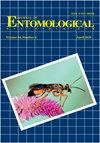Bioactivity of Artemisia vulgaris Essential Oil and Two of Its Constituents Against the Red Flour Beetle (Coleoptera: Tenebrionidae)
IF 0.7
4区 农林科学
Q4 ENTOMOLOGY
引用次数: 0
Abstract
Abstract Tribolium castaneum (Herbst) (Coleoptera: Tenebrionidae) is one of the most destructive pests of stored products. Although there have been studies on the potential use of essential oils from plants in the Artemisia genus as insecticides, no comprehensive bioactivity data are available on the efficacy of Artemisia vulgaris L. (Asterales: Asteraceae) essential oil and its chemical constituents on stored-product pests. Therefore, in this study, the bioactivity of A. vulgaris essential oil and its chemical constituents, eugenol and terpinen-4-ol, against T. castaneum were determined by contact, fumigant, and repellent bioassays. Analysis of contact and fumigant bioassays showed that A. vulgaris essential oil, eugenol, and terpinen-4-ol have contact and fumigant toxicities against T. castaneum, of which terpinen-4-ol has a strong killing effect on larvae and adults, suggesting that terpinen-4-ol may be the main active component of A. vulgaris essential oil in contact and fumigant effects. Additionally, A. vulgaris essential oil and eugenol have higher repellent activity against T. castaneum larvae and adults, whereas the repellent activity of terpinen-4-ol is low, indicating that the main component of A. vulgaris essential oil in repellence may be eugenol. These results further provide relevant theoretical basis for the development of plant essential oil pesticides.青蒿精油及其两种成分对红粉甲虫(鞘翅目:拟甲科)的生物活性
摘要:黄粉虫(Tribolium castaneum)(鞘翅目:拟甲科)是储粮中最具破坏性的害虫之一。虽然已有关于蒿属植物精油作为杀虫剂的研究,但尚无关于蒿属植物精油及其化学成分对储存品害虫的综合生物活性数据。因此,本研究采用接触法、熏蒸法和驱避法测定了香樟挥发油及其化学成分丁香酚和松油烯-4-醇对castaneum的生物活性。接触性和熏蒸性生物测定结果表明,槲皮挥发油、丁香酚和松油烯-4-醇对castaneum幼虫和成虫均具有接触和熏蒸毒性,其中松油烯-4-醇对castaneum幼虫和成虫均有较强的杀伤作用,表明松油烯-4-醇可能是槲皮挥发油接触和熏蒸作用的主要活性成分。此外,香樟精油和丁香酚对蓖麻幼虫和成虫的驱避活性较高,而松油烯-4-醇的驱避活性较低,说明香樟精油的主要驱避成分可能是丁香酚。这些结果进一步为植物精油类农药的开发提供了相关的理论依据。
本文章由计算机程序翻译,如有差异,请以英文原文为准。
求助全文
约1分钟内获得全文
求助全文
来源期刊
CiteScore
1.20
自引率
11.10%
发文量
40
审稿时长
>12 weeks
期刊介绍:
The Journal of Entomological Science (ISSN 0749-8004) is a peer-reviewed, scholarly journal that is published quarterly (January, April, July, and October) under the auspices of the Georgia Entomological Society in concert with Allen Press (Lawrence, Kansas). Manuscripts deemed acceptable for publication in the Journal report original research with insects and related arthropods or literature reviews offering foundations to innovative directions in entomological research

 求助内容:
求助内容: 应助结果提醒方式:
应助结果提醒方式:


